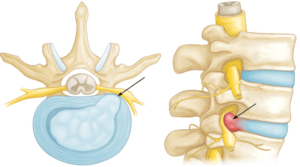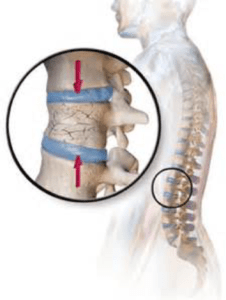Minimally Invasive Spine Surgery (MISS) is becoming some of the most commonly performed spine procedures in the United States. Because MISS decreases the risk of surgical complications and significantly reduce recovery time, more and more surgeons are choosing these approaches over traditional surgery. If non-surgical treatment measures have not decreased your neck and/or back pain, a MISS procedure might be the treatment option you’ve been searching for. Here’s everything you need to know:
Minimally Invasive Spine Surgery for a Herniated Disc
The spine’s vertebrae align to form the spinal canal, which allows the spinal cord to travel from the brain down to the pelvis. Between each vertebrae is a jelly-like structure, known as the intervertebral discs. These discs act as shock absorbers for the spine and create space between each vertebrae to prevent them from coming into direct contact. However, when to much stress is placed on a disc, or they begin to wear over time, they can begin to herniate and protrude into the spinal canal and irritate the spinal nerves. When this occurs, it often results in any of the following symptoms:
- Pain in the neck or lower back
- Pain in the shoulders, arms or legs
- Weakness in the hands or feet
- Tingling or burning in the or extremities (Radiculopathy or Sciatica)

Illustration 1-A herniated disc pinches the spinal cord
A Microdiscectomy is a Minimally Invasive procedure used to remove herniated portions of the spinal disc and relieve pressure on the spinal nerves. This outpatient procedure uses a 1 inch incision in the area of the herniated disc as well as a surgical microscope to remove any pieces of spinal discs or bone spurs that may be compressing the spinal nerve(s).
Minimally Invasive Spine Surgery for Spinal Stenosis
Spinal Stenosis is a condition in which the spaces in the spinal cord begin to narrow which consequently increases pressure on the spinal cord and the nerves of the spine. There are many different reasons why Spinal Stenosis may occur but the most common cause is the aging process. As a person ages, the ligaments of the spine may start to thicken and bone spurs (osteophytes) may also start to form around the spinal cord. This, in turn, causes the spaces in the spinal cord to become narrower.
One Minimally Invasive procedure that can be used is known as Laminectomy. The goal of this outpatient procedure is to use a small (1 inch) incision to remove the domed piece of bone over the spinal canal, known as the lamina. Removing this small piece of bone creates more space in the spinal canal and allows the spinal cord and/or spinal nerves to become decompressed, which results in the relief of pain. In some cases, bone spurs or inflamed pieces of the joints along the spine (facet joints) may also be trimmed to help decompress the spinal nerves.
Minimally Invasive Spine Surgery for Fractured Vertebrae
In severe circumstances, non-operative treatment (such as rest, physical therapy, and pain medication) isn’t enough to heal a vertebral fracture and one of two MISS procedures can be performed.
- Vertebroplasty: Biological cement is injected into the fracture. After a few weeks, the cement fuses the bone and fixates the vertebra.
- Kyphoplasty: The fracture is first treated with biological cement. A small balloon is then inserted into the vertebra and inflated to restore vertebral height and the anatomy of the spinal column.

Illustration 2-Some vertebral fractures require surgery
Both surgeries can provide significant symptom relief and the determination of which procedure may be right for you will be based on your unique condition and history.
Finding a Spine Specialist
Minimally invasive spine surgery is performed by a Neurosurgeon specializing in spine. If you’re suffering from back pain, please give us a call to arrange an appointment.
Dr. Patrick Senatus is a Board Certified Neurosurgeon in New York City with extensive experience in Minimally Invasive and Restorative Spine Surgery. Dr. Senatus employs a personalized patient-centered approach that prioritizes optimum functional outcome and well-being. Each consultation begins with a comprehensive evaluation by Dr. Senatus designed to create an individualized evidence based treatment plan which includes the patient, family, and collaborating providers.
Following a conservative treatment philosophy, Dr. Senatus offers his patients solutions using the most advanced minimally invasive spine surgery. His approach is to perform the most effective and least invasive intervention available, specifically tailored to each patient, guided by the principal that surgical options be considered only after all reasonable non-operative therapies have been exhausted. Returning his patients to a functional pain free lifestyle is the ultimate objective. Contact us today to schedule an appointment!


Recent Comments